The Skull Deformity Implants Market is estimated to be valued at USD 1.3 billion in 2025 and is projected to reach USD 2.9 billion by 2035, registering a compound annual growth rate (CAGR) of 8.5% over the forecast period.
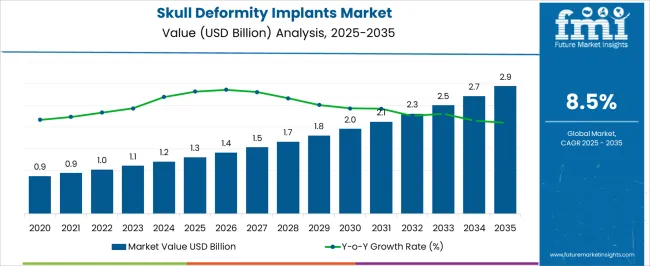
| Metric | Value |
|---|---|
| Skull Deformity Implants Market Estimated Value in (2025 E) | USD 1.3 billion |
| Skull Deformity Implants Market Forecast Value in (2035 F) | USD 2.9 billion |
| Forecast CAGR (2025 to 2035) | 8.5% |
The Skull Deformity Implants market is experiencing steady growth as demand rises for customized cranial implants that address both functional reconstruction and aesthetic correction of cranial deformities. The current landscape is being shaped by technological advancements in biomaterials, 3D printing, and computer-aided design, which have made implants more precise and patient-specific. Increasing incidence of traumatic brain injuries, congenital deformities, and post-surgical defects is fueling adoption across hospitals and specialty centers.
Growth is also being supported by the rising focus on minimally invasive surgeries and biocompatible implant materials that enhance patient outcomes while reducing complications. Surgeons are increasingly adopting software-assisted planning tools that integrate imaging data with implant design, improving surgical precision and post-operative recovery.
The future outlook is marked by growing accessibility to advanced healthcare infrastructure, coupled with rising awareness of reconstructive options among patients and caregivers As healthcare systems expand, particularly in emerging economies, the demand for affordable yet high-performance cranial implants is expected to drive further market expansion.
The skull deformity implants market is segmented by product type, application, end user type, and geographic regions. By product type, skull deformity implants market is divided into Brand Name Neurofeedback Systems and 3D Neurofeedback Systems. In terms of application, skull deformity implants market is classified into Attention Deficit Hyperactivity Disorder (ADHD), Anxiety, Depression, Epilepsy, Insomnia, Drug Addiction, Schizophrenia, and Others. Based on end user type, skull deformity implants market is segmented into Hospitals, Physician Offices, Clinics, and Ambulatory Surgical Centers. Regionally, the skull deformity implants industry is classified into North America, Latin America, Western Europe, Eastern Europe, Balkan & Baltic Countries, Russia & Belarus, Central Asia, East Asia, South Asia & Pacific, and the Middle East & Africa.
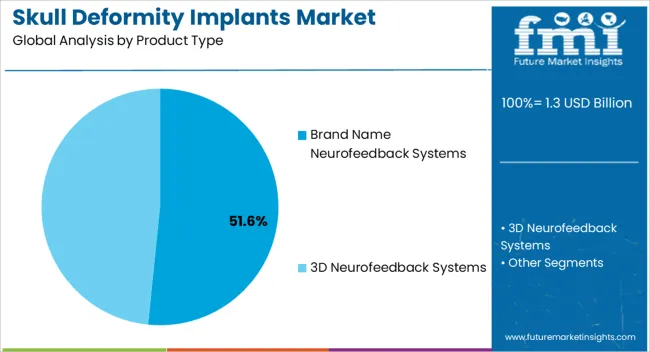
The Brand Name Neurofeedback Systems segment is projected to account for 51.60% of the overall Skull Deformity Implants market revenue in 2025, making it the leading product type. This dominance is being driven by the preference for established and clinically validated systems that ensure reliability, consistent performance, and regulatory compliance. Hospitals and neurosurgical centers favor brand name solutions due to their proven track record, better safety profiles, and availability of after-sales support that enhances user confidence.
The demand for these systems has been reinforced by increasing reliance on advanced diagnostic and monitoring capabilities to support patient rehabilitation alongside surgical interventions. Brand recognition and trust play a significant role in procurement decisions, especially in critical neurosurgical procedures where precision is paramount.
The availability of product warranties, structured service networks, and integration with digital health platforms further enhances the adoption of brand name neurofeedback systems As the clinical community continues to prioritize accuracy and patient safety, this segment is expected to maintain its leadership position in the market.
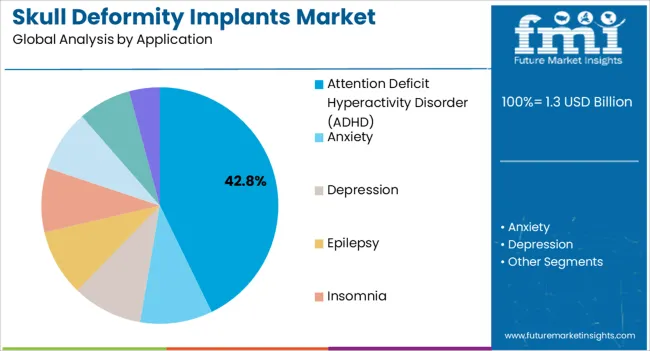
The Attention Deficit Hyperactivity Disorder application segment is expected to capture 42.80% of the Skull Deformity Implants market revenue in 2025, making it the largest application area. The growth of this segment has been fueled by the rising prevalence of ADHD diagnoses across both pediatric and adult populations. Increased awareness among parents, caregivers, and healthcare providers has led to earlier diagnosis and broader treatment adoption.
Neurofeedback-based interventions are being increasingly integrated into ADHD treatment plans to support behavioral improvement and cognitive regulation, thereby expanding the use of implant-assisted monitoring and therapy. Demand has also been supported by advances in digital therapeutics and neuroscience research that validate the role of neurofeedback systems in improving attention and reducing hyperactivity.
Hospitals and clinics are investing in advanced solutions to cater to the growing patient population, while supportive reimbursement structures in certain regions are accelerating adoption The proven clinical benefits and long-term outcomes associated with ADHD-focused interventions are expected to sustain this segment’s leadership over the coming decade.
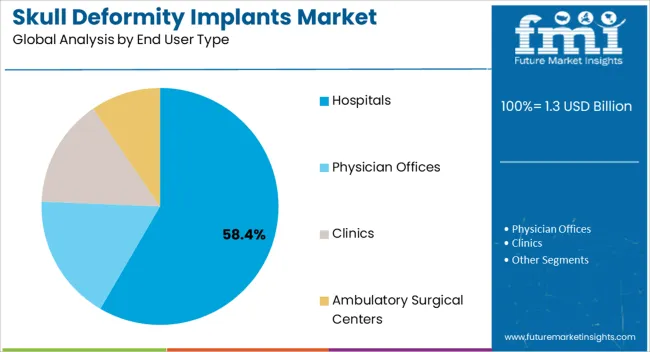
The Hospitals end user segment is anticipated to account for 58.40% of the Skull Deformity Implants market revenue in 2025, positioning it as the largest consumer group. This leadership has been attributed to hospitals serving as primary centers for cranial reconstructive surgeries, trauma care, and rehabilitation programs. The availability of advanced surgical infrastructure, skilled neurosurgeons, and access to high-end imaging and planning tools has strengthened the role of hospitals in adopting skull deformity implants.
Hospitals also provide integrated care pathways that combine surgical intervention with post-operative monitoring and long-term patient management, which enhances patient outcomes. The ability of hospitals to secure regulatory approvals and allocate budgets for high-value devices makes them the most reliable end users for manufacturers.
Increasing patient admissions due to road accidents, congenital abnormalities, and neurosurgical conditions has further accelerated the demand for advanced implant solutions in these facilities With growing investment in hospital infrastructure and the expansion of specialized neurosurgical units, this segment is expected to continue driving the largest share of adoption in the market.
Skull deformity implants are implanted to correct the skull defect which may be a result of severe head injury or trauma, massive cerebral infarction, brain herniation or brain tumour. Skull deformity implants are also used post-decompressive craniectomy. Decompressive Craniectomy is a treatment to cure Cranioplasty. Skull deformity implants help in restoring the integrity, stability the state of the intracranial structure of the skull.
The aesthetic is improved immensely as well as greater protection is provided on implantation of skull deformity implants. Skull deformity implants are successfully implanted recently to reshape the skull and give it a uniform shape for individuals possessing congenital skull abnormalities or unsatisfied with their skull shape.
In accidental and trauma cases, skull deformity implants aid in restoring the stability and integrity, provide oblong continuous appearance as well as helps in maintaining the intracranial pressure. Skull deformity implants facilitate the metabolism of brain tissues, re-establishes the brain protection, restores the function of cranial nerves and reduces the adverse consequences caused by the trauma or accident.
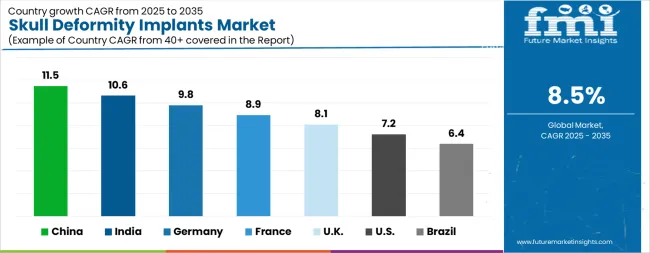
| Country | CAGR |
|---|---|
| China | 11.5% |
| India | 10.6% |
| Germany | 9.8% |
| France | 8.9% |
| UK | 8.1% |
| USA | 7.2% |
| Brazil | 6.4% |
The Skull Deformity Implants Market is expected to register a CAGR of 8.5% during the forecast period, exhibiting varied country level momentum. China leads with the highest CAGR of 11.5%, followed by India at 10.6%. Developed markets such as Germany, France, and the UK continue to expand steadily, while the USA is likely to grow at consistent rates. Brazil posts the lowest CAGR at 6.4%, yet still underscores a broadly positive trajectory for the global Skull Deformity Implants Market. In 2024, Germany held a dominant revenue in the Western Europe market and is expected to grow with a CAGR of 9.8%. The USA Skull Deformity Implants Market is estimated to be valued at USD 484.9 million in 2025 and is anticipated to reach a valuation of USD 974.0 million by 2035. Sales are projected to rise at a CAGR of 7.2% over the forecast period between 2025 and 2035. While Japan and South Korea markets are estimated to be valued at USD 67.5 million and USD 36.3 million respectively in 2025.
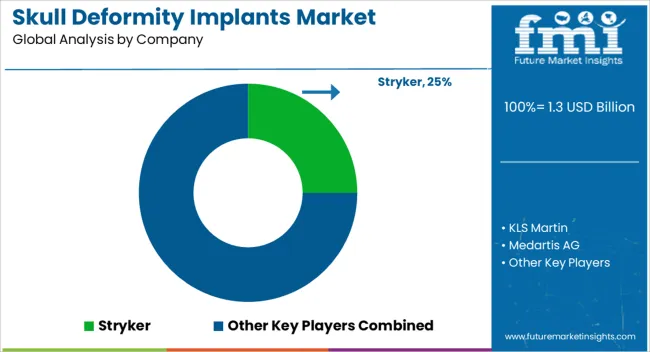
| Item | Value |
|---|---|
| Quantitative Units | USD 1.3 Billion |
| Product Type | Brand Name Neurofeedback Systems and 3D Neurofeedback Systems |
| Application | Attention Deficit Hyperactivity Disorder (ADHD), Anxiety, Depression, Epilepsy, Insomnia, Drug Addiction, Schizophrenia, and Others |
| End User Type | Hospitals, Physician Offices, Clinics, and Ambulatory Surgical Centers |
| Regions Covered | North America, Europe, Asia-Pacific, Latin America, Middle East & Africa |
| Country Covered | United States, Canada, Germany, France, United Kingdom, China, Japan, India, Brazil, South Africa |
| Key Companies Profiled | Stryker, KLS Martin, Medartis AG, Zimmer Biomet, Medtronic, B. Braun Melsungen, DePuy Synthes (Johnson & Johnson), OsteoMed, Xilloc Medical B.V, and Renishaw |
The global skull deformity implants market is estimated to be valued at USD 1.3 billion in 2025.
The market size for the skull deformity implants market is projected to reach USD 2.9 billion by 2035.
The skull deformity implants market is expected to grow at a 8.5% CAGR between 2025 and 2035.
The key product types in skull deformity implants market are brand name neurofeedback systems and 3D neurofeedback systems.
In terms of application, attention deficit hyperactivity disorder (adhd) segment to command 42.8% share in the skull deformity implants market in 2025.






Full Research Suite comprises of:
Market outlook & trends analysis
Interviews & case studies
Strategic recommendations
Vendor profiles & capabilities analysis
5-year forecasts
8 regions and 60+ country-level data splits
Market segment data splits
12 months of continuous data updates
DELIVERED AS:
PDF EXCEL ONLINE
Skull Clamp Market Size and Share Forecast Outlook 2025 to 2035
Minimally Invasive Deformity Correction System Market
Bio-Implants Market Analysis - Size, Share, and Forecast Outlook for 2025 to 2035
Gel Implants Market Analysis - Trends, Share & Forecast 2025 to 2035
Smart Implants Market Size and Share Forecast Outlook 2025 to 2035
Brain Implants Market Size and Share Forecast Outlook 2025 to 2035
Cheek Implants Market
Spinal Implants and Devices Market Size and Share Forecast Outlook 2025 to 2035
Industry Share & Competitive Positioning in Breast Implants Market
Ocular Implants Market
Facial Implants Market
Struts Implants Market
Medical Implants Precision Machining Service Market Size and Share Forecast Outlook 2025 to 2035
Steroid Implants Market Analysis - Size, Share, and Forecast Outlook 2025 to 2035
Humeral Implants Market Growth – Trends & Forecast 2025 to 2035
Aniridia Implants Market Size and Share Forecast Outlook 2025 to 2035
Cosmetic Implants Market Size and Share Forecast Outlook 2025 to 2035
Cervical Implants Market
Contouring Implants Market
Eye Socket Implants Market

Thank you!
You will receive an email from our Business Development Manager. Please be sure to check your SPAM/JUNK folder too.
Chat With
MaRIA